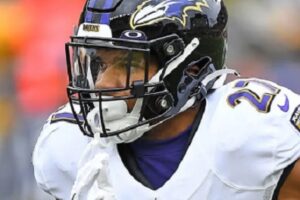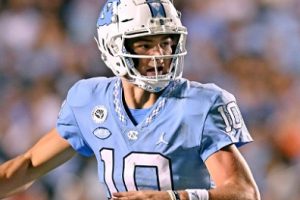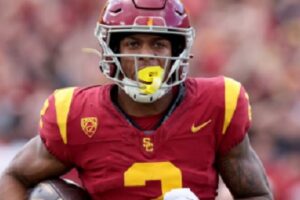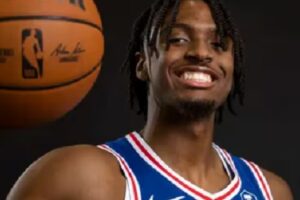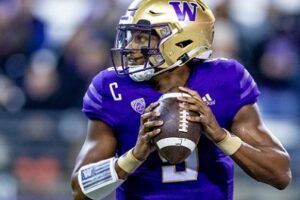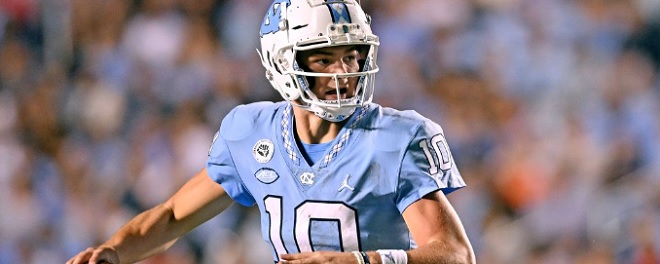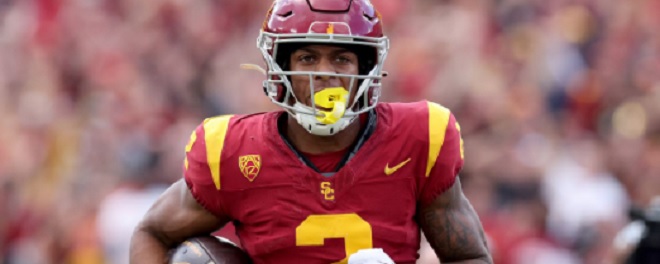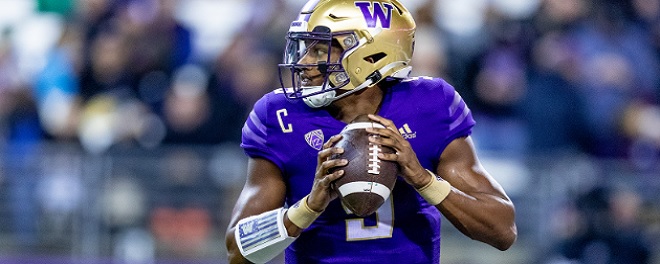April 29, 2012
2012 NFL Draft Winners and Losers – Day 1:
Winners
 Minnesota Vikings: Matt Kalil , OT, USC
Minnesota Vikings: Matt Kalil , OT, USC 
Surprisingly, the Vikings did a masterful job of working the media and generating a nice trade market for the third pick. They were able to pick up three third-day picks, and still land the player they had to draft while moving down one spot. Due to its division, Minnesota had to get a pass protector and blind side blocker to protect 2011 first-rounder Christian Ponder. Kalil is an instant improvement at left tackle for the Vikings.
 Jacksonville Jaguars: Justin Blackmon, WR, Oklahoma State
Jacksonville Jaguars: Justin Blackmon, WR, Oklahoma State 
The Jaguars got their guy. They badly wanted Blackmon, and they only had to give up a fourth-round pick to go up and get him. Jacksonville has to get massive improvements out of Blaine Gabbert. If Gene Smith doesn’t see Gabbert improve in 2012, he could easily be fired by a new owner that didn’t hire him. Surrounding Gabbert with better weapons is one way to do it, and Jacksonville was able to land the top receiver in the draft.
Blackmon had 121 receptions for 1,522 yards and 18 touchdowns in 2011. He was a dynamic, yet extremely consistent, playmaker in 2010, producing 1,782 yards on 111 catches with 20 touchdowns. Blackmon had more than 100 yards receiving in every game he played that season. The 6-foot-1, 207-pounder is a legit No.1 receiver who is a complete package. The Jaguars had to be bold this offseason to get Gabbert turned around, and they made it happen with the top receiving target available.
 Pittsburgh Steelers: David DeCastro, G, Stanford
Pittsburgh Steelers: David DeCastro, G, Stanford 
The Steelers committed robbery by landing DeCastro with the 24th pick. Pittsburgh had a big need for the guard position and was able to land the best one late in the first round. Most projections had DeCastro going within the top-15 picks.
DeCastro was a dominant force for the Cardinal. The 6-foot-5, 310-pounder is an experienced starter who was a Second-Team All-American in 2010 and a First-Team All-American in 2011. Stanford averaged 213.8 rush yards per game with DeCastro paving the way at right guard in 2010. DeCastro and Steelers center Maurkice Pouncey could form one of the best guard-center combos in the NFL.
 New England Patriots: Chandler Jones, DE/OLB, Syracuse and Dont’a Hightower , ILB, Alabama
New England Patriots: Chandler Jones, DE/OLB, Syracuse and Dont’a Hightower , ILB, Alabama
The Patriots had to improve their pass rush, and they used both of their first-rounders to come away with two edge rushers. Jones and Hightower should form a big and physical linebacking corps with Brandon Spikes and Jerod Mayo. All four of those linebackers have versatility, so it will make scheming against New England difficult. The Patriots had one of the worst pass defenses in the NFL in 2011. A large part of that stemmed from them being unable to put consistent pressure on the quarterback. It was the biggest weakness for New England, and the team definitely addressed it with the players who are tough to block coming off the edge.
 St. Louis Rams: Michael Brockers, DT, LSU
St. Louis Rams: Michael Brockers, DT, LSU 
Even though they didn’t land one of the elite-six prospects, the Rams have so many needs that moving down a second time and getting more draft picks makes a lot of sense. Brockers fills a big hole in the middle of their defense. St. Louis has had a weakness at defensive tackle for years. The team tried filling it with veteran free agents, but nobody was making a difference.
Brockers was the best run-stuffing defensive tackle in the draft, so the Rams’ defense should immediately be better at stopping the run next season. Brockers should also help keep occupy guards to keep them from double-teaming either Chris Long or Robert Quinn. In the second round, the team has three picks where it can add talent at wide receiver, linebacker and cornerback. With all holes to fill, it makes sense that the Rams went for quantity.
Losers
 Seattle Seahawks: Bruce Irvin, OLB, West Virginia
Seattle Seahawks: Bruce Irvin, OLB, West Virginia 
The most shocking pick in the first round was the Seahawks taking Irvin with the 15th-overall pick. He looks like a situational pass rusher in a 3-4 defense. Seattle uses a 4-3, so Irvin will have to learn a new position as a Will or Sam linebacker who blitzes off the edge on passing downs. He also has a lot of character concerns and off-the-field issues. This was a terrible pick, and the worst pick in the 2012 draft, especially with players like Melvin Ingram available.
 San Francisco 49ers: A.J. Jenkins, WR, Illinois
San Francisco 49ers: A.J. Jenkins, WR, Illinois 
After Seattle, the second-most shocking pick was the huge reach of Jenkins going to the 49ers. One NFL coach told WalterFootball.com on a phone call during the draft that his team had Jenkins going in the third round. Jenkins is a good speed receiver, but a bigger speed receiver in Stephen Hill was available. San Francisco also could have addressed its offensive line with a player like Cordy Glenn.
Jenkins had a very productive senior season. He caught 90 passes for 1,276 yards and eight touchdowns. Jenkins hauled in 56 passes for 746 yards and seven touchdowns as a junior in 2010. The 6-foot, 190-pounder has the speed to produce some big plays downfield, like he did for Illinois, but he was a big reach in the first round.
 New York Jets: Quinton Coples, DE/OLB, North Carolina
New York Jets: Quinton Coples, DE/OLB, North Carolina 
The Jets got a pass rusher, but for a 4-3 defense. Coples can play in a 3-4, but he is better suited as five-technique defensive end. That position is not a big need for them. They really need an edge rusher, and while Coples is a good athlete, he looks too big to an effective outside linebacker in a 3-4 defense. Coples (6-6, 284) is the prototypical defensive end for a 4-3 defense due to his combination of size, speed and athleticism. New York had an ideal 3-4 edge rusher available in Melvin Ingram, but passed on him. It will be interesting to see if Coples can make the transition to playing outside linebacker in Rex Ryan’s 3-4.
 Cleveland Browns: Trent Richardson, RB, Alabama and Brandon Weeden, QB, Oklahoma State
Cleveland Browns: Trent Richardson, RB, Alabama and Brandon Weeden, QB, Oklahoma State With their first pick, the Browns bit into the smoke from the Vikings and gave up three picks to move up one spot. If they had held tight at four, they could have saved the picks and still landed Richardson. Tampa Bay general manager Mark Dominik said he wasn’t going to trade up, but the Vikings faked Cleveland into believing the Buccaneers would move up to three for Richardson.
After that the Browns reached again. They wanted Kendall Wright, as we had mocked to them, but they didn’t make a move for him, and the Titans selected Wright at 20. Weeden to Cleveland made a lot of sense, and I mocked him to the team in round two. Taking Weeden in the first round was a huge risk. He will be a 29-year old rookie, and even though he is more mature, he still has a transition process like any quarterback from college to the pros. The Big XII does not have defenses like the Steelers, Bengals or Ravens that Weeden will see in six games per season. Overall, the Browns seemed to panic on two occasions in the first round.
 New York Giants: David Wilson, RB, Virginia Tech
New York Giants: David Wilson, RB, Virginia Tech 
The Giants wanted Doug Martin and I had mocked him to them. They were going to take him, but Tampa Bay skipped ahead of them to land Martin. The price for New York to move up a couple spots and land Martin was reasonable, but the Giants didn’t pull the trigger.
In 2011, his first as a starter, Wilson was the ACC Player of the Year. He averaged 5.9 yards per carry and totaled 1,709 yards and nine touchdowns. Wilson also caught 22 passes for 129 yards and a touchdown. He is a well-rounded back whp fits the Giants, but he is a bit of a reach at the end of the first round. New York potentially could have moved down to take him, but because it was set on Martin, the team was probably caught unprepared to go down into the second round. The Giants had to settle for Wilson, and that was a bit of a reach for the defending champs.
2012 NFL Draft Winners and Losers – Day 2:
Winners
 New York Jets: Stephen Hill, WR, Georgia Tech and Demario Davis, OLB, Arkansas State
New York Jets: Stephen Hill, WR, Georgia Tech and Demario Davis, OLB, Arkansas State The Jets had to get a starting wide receiver early in the 2012 NFL Draft. They missed out on Michael Floyd in the first round, but got a nice value on the second day with Stephen Hill. New York traded up for him with the Seahawks after he fell past St. Louis, Buffalo and Miami.
Hill should be a quick starter in for the Jets. He also will be a great fit on deep passes down the field from Tim Tebow. Throughout his college career and last year with Denver, Tebow produced big plays by faking a run and airing the ball deep to a speed receiver. Hill could fill that position and be a quick asset for New York. Davis could be an eventual replacement for Bart Scott.
 Indianapolis Colts: Coby Fleener, TE, Stanford and Dwayne Allen, TE, Clemson
Indianapolis Colts: Coby Fleener, TE, Stanford and Dwayne Allen, TE, Clemson The Colts lost Dallas Clark and Jacob Tamme. Indianapolis got Andrew Luck his top college receiver, while filling a need and adding another weapon in Dwayne Allen. Fleener (6-6, 247) was a dangerous receiver for quarterback Andrew Luck. Fleener had 28 catches for 434 yards and seven touchdowns in 2010. He hauled in 34 receptions for 667 yards and 10 touchdowns this year. Fleener runs good routes and is adept at exploiting the deep middle of the field on seam routes.
Allen amassed 50 receptions for 598 yards and eight touchdowns in 2011. He is a good receiver who also has the size and strength to be a good blocker. The Colts have given Luck two security blankets with Allen and Fleener. Both were also good values where they were selected.
 Green Bay Packers: Jerel Worthy, DT, Michigan State and Casey Hayward, CB, Vanderbilt
Green Bay Packers: Jerel Worthy, DT, Michigan State and Casey Hayward, CB, Vanderbilt The Packers traded up to land Worthy and Hayward. Both picks make a lot of sense. Green Bay really missed Cullen Jenkins last season, and Worthy is a great fit. He can play the five-technique defensive end position in the team’s 3-4 defense and be a physical disruptor on the edge. Hayward is an interception producer who had 13 interceptions over the past two seasons. He has size and instincts. Hayward should be a good understudy to Charles Woodson.
The Packers rarely move up in the draft, so it shows how highly they regarded Worthy and Hayward. Entering the draft, Green Bay had big needs at outside linebacker, defensive end and cornerback. The team has done extremely well filling those holes with Nick Perry, Worthy and Hayward.
 Philadelphia Eagles: Vinny Curry , DE/OLB, Marshall and Mychal Kendricks, ILB/OLB, California
Philadelphia Eagles: Vinny Curry , DE/OLB, Marshall and Mychal Kendricks, ILB/OLB, California The Eagles did well to land a linebacker like Kendricks. He will be a nice complement to DeMeco Ryans. As a senior, Kendricks (6-0, 240) moved to middle linebacker and had a productive season. He totaled 107 tackles with 14.5 tackles for a loss, two interceptions, three sacks and two passes broken up. Kendricks broke out in 2010 as a rush linebacker for the Golden Bears. He recorded 8.5 sacks with 15 tackles for a loss and 66 tackles. Kendricks will be a good attacking linebacker for Philly.
Both Walt and I predicted the Eagles would take Curry because it made a lot of sense. They could use a young end to develop behind veterans Jason Babin and Trent Cole. Curry was the most consistent pass rusher in college football over the past two seasons. He had 12 sacks, 18 tackles for a loss and 94 tackles in 2010. The redshirt senior had 77 tackles with 22 tackles for a loss, 11 sacks, three blocked kicks and seven forced fumbles this year. Philadelphia’s draft haul of Fletcher Cox, Kendricks and Curry should really infuse the team’s front seven with young talent.
 Atlanta Falcons: Peter Konz, C, Wisconsin and Lamar Holmes, OT, Southern Miss
Atlanta Falcons: Peter Konz, C, Wisconsin and Lamar Holmes, OT, Southern Miss The Falcons got a steal when they landed the draft’s top center in the second round. Todd McClure is nearing the end of the line, so Konz could lock down the center position in front of Matt Ryan for another decade.
The Wisconsin center had an excellent 2011 season run blocking for running back Montee Ball. The Badgers had success running up the middle behind Konz (6-5, 315) all year. He had an excellent game blocking Nebraska defensive tackles Jared Crick and Baker Steinkuhler. Konz also did well against Michigan State’s Jerel Worthy. Konz is a good pass protector as well.
Holmes is a sleeper prospect who could provide nice depth initially while developing for a bigger role.
Losers
 Detroit Lions: Ryan Broyles, WR, Oklahoma and Dwight Bentley, CB, Louisiana-Lafayette
Detroit Lions: Ryan Broyles, WR, Oklahoma and Dwight Bentley, CB, Louisiana-Lafayette The Lions got an intriguing player with Broyles, but I don’t like the pick because receiver is only a secondary need. Detroit had big needs among the offensive line and defensive backs, yet the team passed on the top center, Wisconsin’s Peter Konz, along with a couple of good defensive backs (Trumaine Johnson, Jayron Hosley) and a good defensive end (Vinny Curry).
Plus, the Lions already have a young receiver similar to Broyles on the roster in Titus Young. The line really could have benefitted with Konz serving as the replacement to Dominic Raiola. Broyles may not even see the field next season with his knee injury and the veterans in front of him.
Dwight Bentley was Detroit’s third-round pick, and one could argue that better corners were available in Josh Norman and Jayron Hosley. Bentley looks like he is a replacement for Eric Wright, and they have some similarities in their skill sets. Norman is bigger, while Hosley has better ball skills and excelled against better competition. Those two look more like starters while Bentley is probably a nickelback. It feels like the Lions really could’ve done better.
 Denver Broncos: Derek Wolfe, DT, Cincinnati; Brock Osweiler, QB, Arizona State and Ronnie Hillman, RB, San Diego State
Denver Broncos: Derek Wolfe, DT, Cincinnati; Brock Osweiler, QB, Arizona State and Ronnie Hillman, RB, San Diego State I like the Wolfe pick. He was my favorite sleeper prospect in the draft, although I preferred him in a 3-4 defense. The Broncos slightly reached on Osweiler and had a big reach for Hillman. Osweiler was a better value in the third round. Hillman was considered to be a third-day pick who could fall to the late rounds. Denver still had a need at defensive tackle, even after selecting Wolfe, and the team passed on the likes of Alameda Ta’amu and Brandon Thompson.
Wolfe could make an early impact, but Osweiler and Hillman may not provide much of an impact considering they have established veterans ahead of them. Denver is trying to win it all next season, and this draft probably won’t make a significant difference.
 Kansas City Chiefs: Jeff Allen, OT, Illinois and Donald Stephenson, OT, Oklahoma
Kansas City Chiefs: Jeff Allen, OT, Illinois and Donald Stephenson, OT, Oklahoma I’m not a fan of the Chiefs doubling up at tackle, especially considering they have Brandon Albert and Eric Winston already in house. Albert can play guard and is entering a contract year, so one tackle is understandable. However, Kansas City ignored other needs like quarterback and defensive back depth.
 Jacksonville Jaguars: Andre Branch, DE, Clemson and Bryan Anger, P, California
Jacksonville Jaguars: Andre Branch, DE, Clemson and Bryan Anger, P, California The pick of Branch is fine. He graded out as a high second-round pick, and the Jaguars needed a pass rusher. Gene Smith taking Anger in the third round at pick No. 70 is worse than horrible. It is on par with the Seahawks taking Bruce Irvin in the first round. Jacksonville has a lot of needs in the secondary along with needing more help at receiver and the offensive line. There were a lot of good talent available, but Smith took Anger with the 70th pick. It was easily the worst pick of the second day of the draft.
 Houston Texans: DeVier Posey, WR, Ohio State and Brandon Brooks, G/T, Miami of Ohio
Houston Texans: DeVier Posey, WR, Ohio State and Brandon Brooks, G/T, Miami of Ohio The Texans reached for a wide receiver who could have been had on the third day. He was suspended for most of 2011 and had an awful performance at the Senior Bowl. Posey looked slow and disinterested.
Brooks is a quality pick, but at 6-foot-4, 353-pounds it will be interesting to see if he can fit as a zone-blocking offensive lineman. Houston had needs at those positions, but the team maybe could have done better than those two players.
2012 NFL Draft Winners and Losers – Day 3:
Winners
 Cincinnati Bengals: Orson Charles, TE, Georgia and Marvin Jones, WR, California
Cincinnati Bengals: Orson Charles, TE, Georgia and Marvin Jones, WR, California The Bengals snatched a really nice value pick with Charles in the fourth round.
Charles (6-2, 251) had a good junior season with 45 receptions for 574 yards and five touchdowns. There is no doubt that he is extremely fast and can produce big catches downfield. Charles is a mismatch for safeties and linebackers. He needs to improve as a blocker however.
Charles caught 26 passes for 422 yards and two touchdowns as a sophomore in 2010. As a freshman, he had 23 receptions for 374 yards and three touchdowns. Charles should serve as a nice complementary tight end with Jermaine Gresham, and they will give the Bengals a dangerous double tight end set.
Jones was a potential third-rounder who Cincinnati landed at the end of the fifth round. The 6-foot-2, 198-pounder has good speed to go along with quality size. He ran the 40-yard dash in 4.46 seconds at the Scouting Combine. As a senior, Jones was the second-option behind Keenan Allen, but Jones recorded 62 receptions for 846 yards and three touchdowns. He had a fabulous showing at the Senior Bowl.
The Bengals also took a safety in Boise State’s George Iloka. All three of those players could make an impact for Cincinnati.
 Detroit Lions: Ronnell Lewis, OLB, Oklahoma and Chris Greenwood, CB, Albion
Detroit Lions: Ronnell Lewis, OLB, Oklahoma and Chris Greenwood, CB, Albion The Lions had a need at linebacker and filled it with a violent defender who could be an intimidating presence.
Lewis was a second-day value who Detroit landed at pick No. 125. The 6-foot-2, 253-pounder is well-built physical specimen. He had 59 tackles with 13 tackles for a loss, 5.5 sacks, five passes batted away, a forced fumble and an interception in 10 games in 2011. Lewis played excellently against Texas A&M and its two very good offensive tackles, Jake Matthews and Luke Joeckel.
For the Lions, Lewis can be a Sam (strongside) linebacker who plays defensive end in passing situations. With the other young playmakers on Detroit’s defensive line, Lewis could draw some favorable matchups and rack up some splash plays.
Greenwood is an interesting cornerback with some size and speed.
Defensive coordinator Gunther Cunningham compared Greenwood to Brandon Carr, a successful fifth-round pick Cunningham had a part in taking for Kansas City. Greenwood should compete at corner and provide special teams help.
In the seventh round, the Lions took a chance on Travis Lewis. He had a bad senior season while playing injured, but he is a good gamble in the final round.
 Carolina Panthers: Frank Alexander, DE/OLB, Oklahoma; Joe Adams, WR, Arkansas and Josh Norman, CB, Coastal Carolina
Carolina Panthers: Frank Alexander, DE/OLB, Oklahoma; Joe Adams, WR, Arkansas and Josh Norman, CB, Coastal Carolina The Panthers had an excellent haul of talent in the fourth and fifth round. They started by sacrificing their 2013 third-round pick in order to move up and select Alexander. That is a significant investment in this pass rusher.
Alexander had 54 tackles, 8.5 sacks, 19 tackles for a loss, eight passes broken up, three forced fumbles and one interception in 2011. Early in the season, he put constant heat on the quarterback and demonstrated a relentless motor. He tailed off in the second half of the season as Oklahoma had some rough games. Alexander (6-4, 270) has some speed, pass rushing moves and a relentless motor. He has been an underrated prospect throughout the 2012 draft process.
The 5-foot-10, 174-pound Adams projects to being a good slot receiver in the NFL. He had a strong senior season with 54 receptions for 652 yards and three touchdowns. Adams is quick receiver and a good route-runner.
Carolina landed a player who could develop into a starter at a premium position on defense with Norman. He laid claim to be being the top prospect at the East-West Shrine practices. All week, Norman had dominant practices that showcased him producing some splash plays. In his collegiate career, the 6-foot, 197-pounder totaled 13 interceptions with 35 passes broken up, four forced fumbles, four blocked kicks and 196 tackles. He broke out with eight interceptions as a sophomore in 2009. Norman has the physical skill set to potentially be a starter in the NFL.
 Buffalo Bills: Nigel Bradham, OLB, Florida State; Zebrie Sanders, OT, Florida State and Tank Carder, ILB/OLB, TCU
Buffalo Bills: Nigel Bradham, OLB, Florida State; Zebrie Sanders, OT, Florida State and Tank Carder, ILB/OLB, TCU Bradham (6-2, 241) is an improved attacking linebacker who is very physical and would fit a 4-3 as a Sam linebacker. Bradham collected 86 tackles with 9.5 tackles for a loss, two sacks, two interceptions and a forced fumble as a senior. He had 97 tackles with 6.5 tackles for loss, five sacks and five passes broken up in 2010.
The 6-foot-6, 320-pound Sanders is a quality right tackle prospect to land in the fifth round. He is very experienced with quickness and mobility. Sanders has the length that the Bills want on the edge. He lacks strength but could easily change that after getting into an NFL strength and conditioning program. The Bills may have landed a starting right tackle in the fifth round and that is good value.
The 6-foot-3, 237-pound Carder is a hard-nosed football player who will probably fit the Bills as a Will (weakside) linebacker. He ran the 40-yard dash at the Combine in 4.56 seconds, an excellent time for a linebacker. For both 2011 and 2010, Carder was the Mountain West Conference Defensive Player of the Year after two productive seasons. Eventually, he and Bradham should fill Buffalo’s long-term starters at outside linebacker while being fabulous special teamers immediately. That is excellent value on the third day.
 Pittsburgh Steelers: Alameda Ta’amu, NT, Washington and Chris Rainey, RB/WR, Florida
Pittsburgh Steelers: Alameda Ta’amu, NT, Washington and Chris Rainey, RB/WR, Florida The Steelers needed a long-term replacement for Casey Hampton at nose tackle, and they were able to land one of the top nose tackles in the draft, Alameda Ta’amu in the fourth round. The 6-foot-3, 337-pounder is a natural zero-technique in a 3-4 defense. Landing him in the fourth round is excellent value.
Ta’amu collected 30 tackles with seven tackles for a loss and 3.5 sacks in 2011. He is more disruptive at the point of attack than his numbers indicate. Pittsburgh did a fabulous job of filling a need with the best player available.
Rainey will provide a nice explosive rotational player for the Steelers’ offense at running back and wide receiver. They also upgraded their special teams. Rainey had six blocked punts in his career, and could continue to be a dangerous special teams player in the NFL. He will give Pittsburgh’s backfield an explosive speed element it has missed since Willie Parker.
 Houston Texans: Jared Crick, DE/DT, Nebraska and Randy Bullock, K, Texas A&M
Houston Texans: Jared Crick, DE/DT, Nebraska and Randy Bullock, K, Texas A&M In my final seven-round mock draft, I had the Texans taking Crick in the third round, so landing him in round four was a nice value for Houston. The Texans could use some depth among their five-technique defensive ends, especially with Antonio Smith aging. Crick could be a long-term starter on the other side from J.J. Watt.
At 6-foot-4, 279-pounds, Crick has the strength to be a quality run defender on the edge. That is evident in his notching 73 tackles in 2009 and 70 tackles in 2010. He is also no slouch as a pass rusher. After recording 9.5 sacks as a sophomore next to Ndamukong Suh, Crick matched that total as a junior after Suh left.
Crick totaled 22 tackles, 2.5 tackles for a loss, one sack, one pass broken up and one blocked kick in only five games in 2011. The senior missed the majority of the season with a torn pectoral muscle. He could be a steal since he was previously viewed as a potential first-round pick before the injury.
Another player I predicted the Texans would take is Bullock.
Bullock was the AP’s All-American First-Team selection at kicker after being one of the most accurate kickers in college football in 2011. He made 29-of-33 field goal attempts. On extra points, Bullock was 55-of-57. He was 16-of-21 in 2010 and was good on all 50 extra point attempts. Bullock made all 51 of his extra point attempts in 2009 and was 12-of-19 on field goal attempts. His career long field goal was from 50 yards entering the 2011 season.
Houston had a hole at kicker and addressed it with the best one in the draft.
 Philadelphia Eagles: Brandon Boykin, CB, Georgia; Marvin McNutt, WR, Iowa and Brandon Washington, G, Miami
Philadelphia Eagles: Brandon Boykin, CB, Georgia; Marvin McNutt, WR, Iowa and Brandon Washington, G, Miami The Eagles continued their strong draft by grabbing Boykin in the fourth round.
Boykin (5-9, 183) immediately offers a lot on special teams and as a slot corner. He was one of the top kick returners in college football and is a quality cornerback.
In 2011, Boykin had 55 tackles, 11 tackles for a loss, nine passes broken up, three interceptions and two forced fumbles, as well as three touchdowns on offense (two receiving, one rushing). He averaged 22 yards per kick return and 13 yards per punt return. Boykin had a monster Outback Bowl against Michigan State with a punt returned 92 yards for a touchdown and a touchdown catch. He also scored a safety for the Bulldogs. On defense in 2010, Boykin had 44 tackles with 6.5 tackles for a loss and three interceptions.
Boykin is a gritty corner who fell in the draft because of a broken leg at the Senior Bowl, but he is a second-day value who Philadelphia landed on day three.
McNutt is an underrated prospect and could be a steal. He snagged 82 receptions for 1,315 yards and 12 touchdowns as a senior. McNutt recorded 53 receptions for 861 yards and eight touchdowns in 2010. The 6-foot-2, 216-pounder would have had even more production if he had played in a better passing offense.
McNutt has deceptive speed, good hands and runs good routes. He is capable of making big plays downfield. Even though McNutt ran the 40-yard dash at the Combine in 4.54 seconds, speed concerns pushed him down into the sixth round. He is a excellent value for Philly, as teams told him that he should go in the second through fourth round.
Washington (6-4, 320) is athletic enough to play tackle, but is a better fit at guard. He was a good run blocker for Lamar Miller in 2011. Washington was a nice selection in the sixth round to give the Eagles offensive line some depth.
 Indianapolis Colts: Josh Chapman, DT, Alabama; Vick Ballard, RB, Mississippi State and Tim Fugger, DE, Vanderbilt
Indianapolis Colts: Josh Chapman, DT, Alabama; Vick Ballard, RB, Mississippi State and Tim Fugger, DE, Vanderbilt The Colts landed some quality players with the first and last pick in the fifth round. Both could contribute quickly for Indianapolis.
The 6-foot-1, 310-pound Chapman was Alabama’s nose tackle in its 3-4 defense, and he had a quality 2011 season. Chapman did a good job of plugging his gap and occupying blockers to keep them off the Crimson Tide’s inside linebackers. He recorded 23 tackles with 3.5 tackles for a loss, one sack and two passes batted down this year. Chapman showed his toughness by playing with a torn knee ligament for most of the 2011 season.
Ballard (5-10, 219) is a sleeper running back who could surprise at the next level. He is a physical runner who has some quickness to be a downhill runner. In 2011, Ballard totaled 1,189 yards and 10 touchdowns for an average of 6.1 yards per carry. To end the year, he ran for 180 yards against Wake Forest after totaling 144 yards against Ole Miss. Ballard had a breakout junior season when he ran for 968 yards on 186 carries (5.3 average) with 19 touchdowns.
The Colts will at least get a good rotational back in Ballard, and he could end up pushing to be the starter.
Fugger is a steal in the seventh round. He is a pass rusher who could fit as an outside linebacker in the Colts new 3-4 defense or as an inside linebacker.
Fugger (6-3, 248) flashed some pass-rush ability as a senior. He has quickness around the edge and rushes with good leverage. Fugger also has a relentless motor that never quits. He totaled 33 tackles with 13.5 tackles for a loss, seven sacks, three forced fumbles and three passes broken up this year. Fugger was a Second-Team All-SEC selection.
Chapman, Ballard and Fugger are physical blue collar players who will help the Colts.
 San Diego Chargers: Ladarius Green, TE, Louisiana-Lafayette
San Diego Chargers: Ladarius Green, TE, Louisiana-Lafayette 
I really like the Chargers taking the speedy and athletic Green to be the heir apparent behind Antonio Gates.
Green (6-5, 237) caught 51 passes in 2011, for 606 yards and eight touchdowns. He had a similar season in 2010 when he hauled in 44 passes for 794 yards and seven touchdowns. Green has the frame to add some more bulk for blocking, but should be a receiving threat in the Chargers’ offense and provide some long-term continuity with a receiving tight end for Philip Rivers.
Losers
 Washington Redskins: Kirk Cousins, QB, Michigan State
Washington Redskins: Kirk Cousins, QB, Michigan State 
Obviously, the Redskins would disagree with this, but they took a backup quarterback over other players who could contribute as rookies. Washington could use another running back but took Cousins over Robert Turbin.
The Redskins also need help with the defensive backs, and they could’ve had Brandon Boykin. They could use offensive line help as well, and players like Brandon Mosley, Joe Looney, Zebrie Sanders and Andrew Datko were available. Washington has a number of needs and the team lost picks this year and in future drafts via the Robert Griffin trade, so taking a player that only projects as Griffin’s backup for four years is questionable thinking.
The Redskins got some nice depth and scheme fits in linebacker Keenan Robinson, guard Adam Gettis and running back Alfred Morris. Those are solid picks, but they aren’t steals that make up for the head-scratching pick of Cousins.
 Tampa Bay Buccaneers: Najee Goode, ILB, West Virginia and Keith Tandy, CB, West Virginia
Tampa Bay Buccaneers: Najee Goode, ILB, West Virginia and Keith Tandy, CB, West Virginia Goode isn’t a bad prospect, but unless he beats out Mason Foster or Quincy Black, he won’t see the field in the next few seasons barring injury. The reason why I don’t like this pick is because the Buccaneers have a massive need at corner. Nebraska’s Alfonzo Dennard and Coastal Carolina’s Josh Norman were still available. Both could have been instant competition in Tampa Bay with starting potential.
Goode, on the other hand, looks like a career backup and special teamer. To make matters worse, Norman went three picks later to a division rival.
Tampa Bay addressed cornerback in the fifth round with West Virginia’s Keith Tandy. I like him as a player, but he seems redundant for Buccaneers. In the NFL, Tandy (5-10, 202) projects as a slot corner, and Tampa Bay already have a few of those in Eric Wright and Ronde Barber. The Buccaneers still have a bigger need for an outside corner with length.
Yet in the seventh round, they took another running back in Utah State’s Michael Smith. He may not make the team, but could be a speedy change-of-pace and special teams contributor if he does. Tampa Bay’s final pick, Northwestern’s Drake Dunsmore, is a tight end/h-back/fullback tweener who will play tight end on the roster.
|
|
2024 NFL Mock Draft - April 16
NFL Power Rankings - Feb. 22
Fantasy Football Rankings - Feb. 19
NFL Picks - Feb. 12

